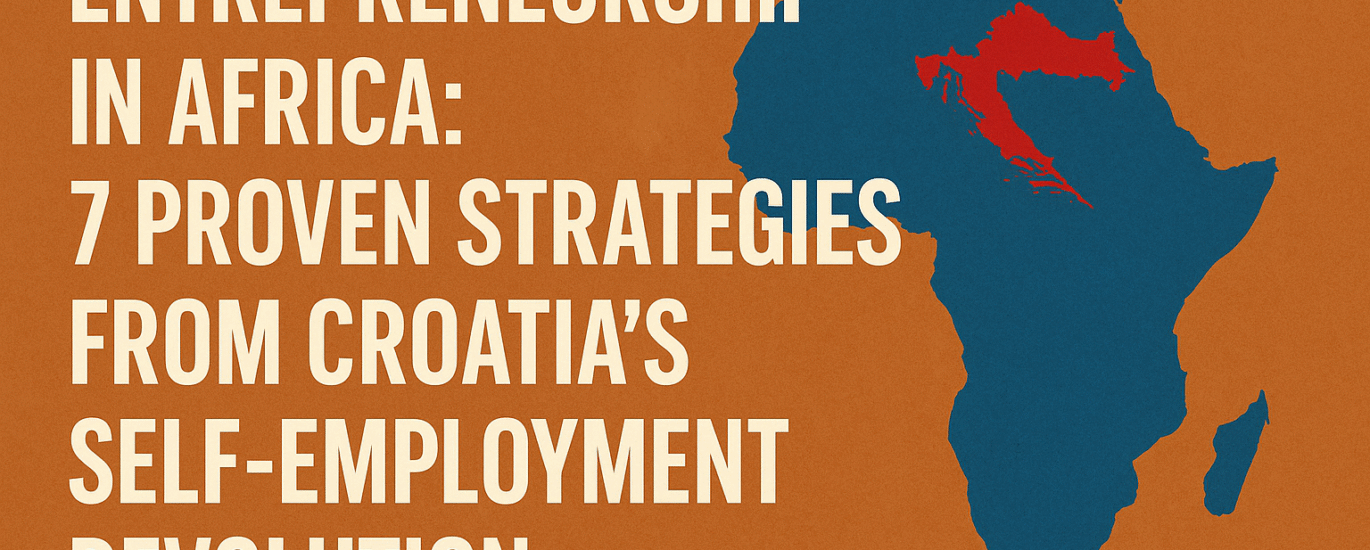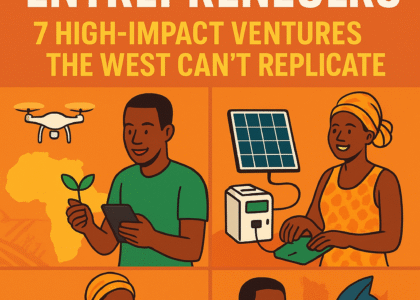It’s long enough to rank on Google (ideal for SEO: 1,500 to 1,800 words), short enough to keep readers engaged, and fully optimized with headings, keywords, and a clear call to action.
—
Entrepreneurship in Africa: 7 Proven Strategies from Croatia’s Self-Employment Revolution
Africa’s Moment to Build Entrepreneurs, Not Jobseekers
Across Africa, millions of young people wake up each day with ambition but limited opportunity. Despite significant innovation and digital adoption, unemployment and underemployment remain persistent challenges.
Yet, halfway around the world, a small European country provides a strong example of what’s possible when government, community, and vision come together.
Since launching its self-employment support program in 2016, Croatia has helped nearly 50,000 people start their own businesses, turning jobseekers into employers. The initiative, funded by the Croatian government and the European Union, has distributed over €451 million in grants, offering up to €15,000 per entrepreneur.
The result? Croatia’s unemployment rate dropped from 16.1% in 2016 to 4% by mid-2025, becoming one of the lowest in Europe.
The lesson for Africa is clear: invest directly in people, not just in programs. Let’s explore seven proven strategies African nations can adopt from Croatia’s success story.
—
1. Fund Startups Directly, Small Grants, Big Impact
One of Croatia’s most effective ideas was offering non-repayable grants to individuals who wanted to start a trade, business, or company. Instead of overwhelming entrepreneurs with complex loans or endless training, the government provided grants of €7,000 to €15,000. This amount was enough to buy tools, rent a workspace, and launch quickly.
This straightforward model empowered nearly 50,000 people to take control of their livelihoods.
What Africa Can Learn:
Most African nations rely on loan-based funding or bureaucratic approval systems that discourage applicants. To spark real entrepreneurship, governments and financial institutions must:
– Launch national self-employment grant programs accessible through online portals.
– Target youth, women, and rural innovators who are usually locked out of formal finance.
– Use community-based vetting to ensure transparency and fairness.
Example:
Kenya’s Ajira Digital program and Nigeria’s YouWiN! Connect has laid early foundations. With Croatia-style simplicity and consistent funding, these models can multiply their impact.
—
2. Simplify Business Registration and Taxation
Croatia’s flat-rate taxes made entrepreneurship easy, with no complicated licenses and lower costs for small businesses.
In Africa, new entrepreneurs often face weeks of paperwork, expensive permits, and unclear tax rules. This discourages innovation and drives many into the informal economy.
What Africa Can Do:
– Implement one-stop online registration systems for all business types.
– Offer tax holidays of 1 to 3 years for startups and youth-owned enterprises.
– Introduce flat-rate tax systems based on turnover, not profit, helping small businesses grow without fear.
Example:
Rwanda already allows full business registration in under 6 hours online, a system that could easily be replicated across ECOWAS, SADC, and EAC regions.
—
3. Build Skills First, Then Fund
Croatia’s program required applicants to complete entrepreneurship training before receiving grants. This ensured that funds were used effectively and businesses survived beyond the first year.
African entrepreneurship programs often skip this step, giving funds without equipping people to manage them.
What Africa Can Do:
– Introduce national entrepreneurship academies run in partnership with universities and private firms.
– Teach practical skills, like bookkeeping, digital marketing, and customer service.
– Make training a gateway to funding, not an afterthought.
Example:
Ghana’s National Entrepreneurship and Innovation Programme (NEIP) has shown how mandatory training can reduce grant misuse while improving startup success rates.
—
4. Co-Finance with Development Partners
Croatia leveraged EU funding through the European Social Fund Plus (ESF+) and its National Recovery and Resilience Plan (NPOO). This co-financing model created stability and accountability.
African governments can achieve similar results through partnerships with:
– The African Development Bank (AfDB)
– The United Nations Development Programme (UNDP)
– The World Bank
– Local banks and private investors
What Africa Can Do:
– Create blended finance models, 50% public and 50% donor or private sector.
– Prioritize performance-based disbursement by releasing funds in milestones.
– Ensure transparent reporting systems to maintain trust.
This approach reduces public financial strain while increasing entrepreneurship impact.
—
5. Create Public-Private Ecosystems
Croatia’s entrepreneurship ecosystem works because government, business, and academia collaborate seamlessly. Each group plays a role: policymakers simplify rules, companies mentor startups, and universities provide training.
Africa’s private sector, especially telecoms, banks, and energy firms, can be powerful allies in youth entrepreneurship.
What Africa Can Do:
– Launch corporate-startup mentorship programs that pair executives with young founders.
– Offer tax credits to companies that invest in youth-led ventures.
– Establish innovation hubs co-managed by public and private institutions.
Example:
In Nigeria, the Tony Elumelu Foundation has shown how private-led funding can transform thousands of African entrepreneurs with a mix of capital and mentorship.
—
6. Focus on Sectors that Drive Jobs
Croatia’s top-funded sectors included construction (28%), personal and repair services, and professional technical services. Africa’s strongest opportunities lie in:
– Agribusiness (food processing, logistics, packaging)
– Renewable Energy (solar, waste-to-energy, off-grid solutions)
– Creative Industries (fashion, crafts, music, film)
– ICT and Fintech (mobile apps, payments, data services)
– Tourism (eco-tourism, digital travel services)
What Africa Can Do:
Each country should map its top 5 high-impact sectors and align funding, tax relief, and training toward them.
Example:
Senegal’s DER Fonds d’Appui à l’Entrepreneuriat Rapide focuses on women and youth in agriculture and technology, creating scalable job growth.
—
7. Track Results and Celebrate Success
Croatia didn’t just distribute funds; it measured the results and shared the stories. Public trust grew as citizens saw the impact.
African entrepreneurship programs often lack visibility and data, making it hard to justify budgets or inspire participation.
What Africa Can Do:
– Build public dashboards showing how many startups were funded, where, and with what outcomes.
– Host annual entrepreneurship awards to celebrate impact and innovation.
– Empower local media to share startup success stories across languages and regions.
When people see entrepreneurship changing lives, it becomes a cultural aspiration, not just an economic policy.
—
The Road Ahead: Africa’s Self-Employment Revolution
Africa has the youngest population in the world and one of the fastest-growing digital economies. But the missing link is often trust in local talent and access to early capital.
Croatia’s story demonstrates that small, targeted grants and effective training systems can transform unemployment into innovation.
If every African country empowered just 10,000 citizens per year through such initiatives, the continent could create over 500,000 new businesses annually, thereby fueling job creation, exports, and overall resilience.
The future of Africa isn’t in job hunting; it’s in job creation.
—
FAQ Section
1. Why is Croatia’s model relevant to Africa?
Because it focuses on simplicity and inclusion, with small grants, easy rules, and training-first policies. Africa’s youth can thrive under the same structure.
2. How can African governments start?
Begin with national pilot programs targeting unemployed youth, streamline digital applications, and partner with donor agencies for co-funding.
3. Which African countries are already close?
Rwanda, Ghana, and Kenya lead in digitized business registration and startup support. Their next step is adopting direct self-employment grants.
4. How can rural areas be included?
By using mobile applications and local development offices to identify entrepreneurs without internet access.
5. What makes this model sustainable?
Training, accountability, and data tracking—not just disbursing funds. When entrepreneurs succeed, they inspire and support the next generation.




